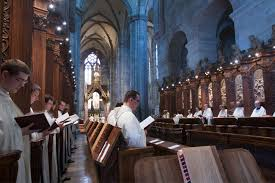1. Characteristics of the Carthusian Liturgy
According to the words of Guigo I, the first legislator of the Carthusian vocation, the liturgy is the noblest part of our life. The Carthusian liturgy is marked by their eremitical vocation. Their particular Gregorian chant is part of their heritage which has been kept from the very beginning; it favors interiority and spiritual sobriety. As soon as they arrived in the Chartreuse, Saint Bruno and his companions created a particular liturgy adapted to their eremitical vocation and to the small size of their community. Over the centuries, our fathers have been careful to preserve this liturgy, adapted to our solitary and contemplative life. The texts and rubrics of the Carthusian liturgy have been revised according to the guidelines of the Second Vatican Council.
In comparison with the Roman liturgy, the Carthusian rite is characterized by a great simplicity and sobriety in its external forms, which favor the union of the soul with God, beyond the visible and sensitive expressions. Some of the distinctive elements of our liturgy are: the numerous periods of silence, the prohibition of all musical instruments, the sober Gregorian chant, the absence of polyphony. Besides, almost all the texts we sing are scriptural.
2. The Eucharistic sacrifice
The celebration of the Eucharistic sacrifice is the centre and summit of community life: every day the monks gather to celebrate the Lord’s Passover. The Carthusians have preserved their own rite of Mass, which dates back to the 11th-12th centuries, and which has a monastic origin but is a branch of the Roman rite. This Eucharist can only be concelebrated on days when the Carthusian life has a community character: Sundays and major feasts. On other days there is only one celebrant at the altar and the Eucharistic prayer is said in a low voice. The community participates in this Eucharistic liturgy through Gregorian chant, interior prayer and communion. The community prostrates itself in adoration during the consecration. It is characteristic of the Carthusian rite of Mass that the priest is almost always alone in the sanctuary (the other ministers withdraw when their service is completed), that he extends his arms like Christ on the Cross during the Eucharistic prayer, and that there is no final blessing.
At another time of the day, normally after the conventual Mass, each monk priest celebrates the Holy Mysteries in a solitary chapel, making his own the universal significance of the Eucharistic sacrifice. A moment of intensity and recollection.
3. The Offices of the Hours
Another highlight of the liturgical day is the office celebrated in church in the middle of the night (Matins and Lauds): for two or three hours, depending on the day, there is an alternation of singing of psalms and reading of the Sacred Scripture or the Fathers of the Church, times of silence and intercessory prayers. All the Carthusians like particularly this long night Office, when each one, united with all his brothers, but nevertheless in a personal way, can experience an intense and profound communion with God.
The noted chant (antiphons, responses, hymns, proper of the Mass, Kyriale) is always in Latin, according to the Gregorian melodies proper to the Carthusians. Some houses of the Order sing the psalmody in vernacular, others in Latin. The readings are in vernacular. In cell, each one can choose to recite the office in Latin or in vernacular, according to his own inclination.
Towards the end of the day the monks gather again in the church to celebrate the office of Vespers. The other parts of the office are celebrated by the monks in their cells, except on Sundays and certain feast days when they are sung in church. In addition to the Divine Office, the Carthusians recite daily the Office of the Virgin Mary in their cells and, once a week, a special Office for the Dead: they implore God to receive into his eternal Kingdom all those who have left this life.
Coming back again and again throughout the day to celebrate the Divine Office is an invaluable help in achieving the monk’s goal of continual prayer.
4. The Blessed Virgin Mary
“Our hermitages are dedicated in the first place to the Blessed Virgin Mary and to St John the Baptist, our principal heavenly patrons… Besides the Divine Office, our Fathers have transmitted the Office of the Blessed Virgin Mary to us. Ordinarily, each one of its Hours precedes the corresponding Hour of the Divine Office. By this prayer we celebrate the eternal newness of the mystery in which Mary engenders Christ spiritually in our hearts” (Statutes 10.10 and 21.12). Besides this expression of our devotion to her, whom we are accustomed to call ‘the unequalled Mother of the Carthusians’ (Mater singularis cartusiensium), we venerate and honor her by praying the Angelus four times a day (morning, noon, evening and at the end of Lauds). We also recite a ‘Hail Mary’ whenever we enter our hermitage from the cloister, in a room intended for this purpose. In all the houses of the Order a Conventual Mass in honor of the Virgin Mary is celebrated weekly, normally on Saturday. Mary is in our formula of profession. Beyond these customs, each one is encouraged to cultivate a living, filial and tender relationship with the Mother of the Lord, as she leads us to Jesus. “Mary, image of the Church, the Bride without spot or wrinkle, which by imitating you ‘preserves with virginal purity an integral faith, a firm hope and a sincere charity’ (LG 64), sustain consecrated persons on their journey towards the sole and eternal Blessedness.” (Vita Consecrata, 112).
*
Thanks to the liturgy, a charterhouse does not remain a group of solitaries isolated from each other. Rather, it becomes a true monastic community, thus manifesting the mystery of the Church and finding in it its place through the public worship it renders to God.

No comments:
Post a Comment